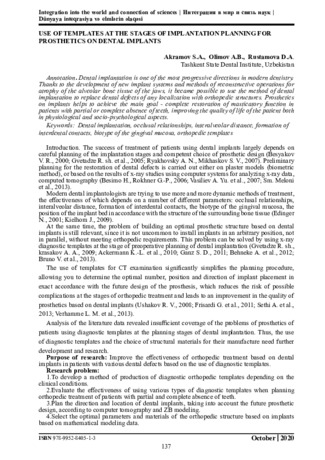
137
October 2020
Integration into the world and connection of sciences | Интеграция в мир и связь наук |
Dünyaya inteqrasiya və elmlərin əlaqəsi
ISBN
978-9952-8405-1-3
USE OF TEMPLATES AT THE STAGES OF IMPLANTATION PLANNING FOR
PROSTHETICS ON DENTAL IMPLANTS
Akramov S.A., Olimov A.B., Rustamova D.A
.
Tashkent State Dental Institute, Uzbekistan
Annotation. Dental implantation is one of the most progressive directions in modern dentistry.
Thanks to the development of new implant systems and methods of reconstructive operations for
atrophy of the alveolar bone tissue of the jaws, it became possible to use the method of dental
implantation to replace dental defects of any localization with orthopedic structures. Prosthetics
on implants helps to achieve the main goal - complete restoration of masticatory function in
patients with partial or complete absence of teeth, improving the quality of life of the patient both
in physiological and socio-psychological aspects.
Keywords: Dental implantation, occlusal relationships, interalveolar distance, formation of
interdental contacts, biotype of the gingival mucosa, orthopedic templates
Introduction.
The success of treatment of patients using dental implants largely depends on
careful planning of the implantation stages and competent choice of prosthetic design (Besyakov
V. R., 2000; Gvetadze R. sh. et al., 2005; Ryakhovsky A. N., Mikhaskov S. V., 2007). Preliminary
planning for the restoration of dental defects is carried out either on plaster models (biometric
method), or based on the results of x-ray studies using computer systems for analyzing x-ray data,
computed tomography (Besimo H., Rokhner G.-P., 2006; Vasiliev A. Yu. et al., 2007; Sm. Meloni
et al., 2013).
Modern dental implantologists are trying to use more and more dynamic methods of treatment,
the eff ectiveness of which depends on a number of diff erent parameters: occlusal relationships,
interalveolar distance, formation of interdental contacts, the biotype of the gingival mucosa, the
position of the implant bed in accordance with the structure of the surrounding bone tissue (Edinger
N., 2001; Kielhom J., 2009).
At the same time, the problem of building an optimal prosthetic structure based on dental
implants is still relevant, since it is not uncommon to install implants in an arbitrary position, not
in parallel, without meeting orthopedic requirements. This problem can be solved by using x-ray
diagnostic templates at the stage of preoperative planning of dental implantation (Gvetadze R. sh.,
krasakov A. A., 2009; Ackermann K.-L. et al., 2010; Ganz S. D., 2011; Behneke A. et al., 2012;
Bruno V. et al., 2013).
The use of templates for CT examination signifi cantly simplifi es the planning procedure,
allowing you to determine the optimal number, position and direction of implant placement in
exact accordance with the future design of the prosthesis, which reduces the risk of possible
complications at the stages of orthopedic treatment and leads to an improvement in the quality of
prosthetics based on dental implants (Ushakov R. V., 2008; Frisardi G. et al., 2011; Sethi A. et al.,
2013; Verhamme L. M. et al., 2013).
Analysis of the literature data revealed insuffi
cient coverage of the problems of prosthetics of
patients using diagnostic templates at the planning stages of dental implantation. Thus, the use
of diagnostic templates and the choice of structural materials for their manufacture need further
development and research.
Purpose of research:
Improve the eff ectiveness of orthopedic treatment based on dental
implants in patients with various dental defects based on the use of diagnostic templates.
Research problem:
1.To develop a method of production of diagnostic orthopedic templates depending on the
clinical conditions.
2.Evaluate the eff ectiveness of using various types of diagnostic templates when planning
orthopedic treatment of patients with partial and complete absence of teeth.
3.Plan the direction and location of dental implants, taking into account the future prosthetic
design, according to computer tomography and ZB modeling.
4.Select the optimal parameters and materials of the orthopedic structure based on implants
based on mathematical modeling data.

138
Октябрь 2020
Integration into the world and connection of sciences | Интеграция в мир и связь наук |
Dünyaya inteqrasiya və elmlərin əlaqəsi
DOI
http://doi.org/10.37057/A_2
5. Develop practical recommendations for the use of diagnostic templates in the comprehensive
rehabilitation of patients with partial and complete absence of teeth.
Scientifi c novelty
1.For the fi rst time, the choice of material for the production of diagnostic templates was justifi ed,
which made it possible to increase the information content of CBCT research at the stage of
preoperative diagnosis.
2.For the fi rst time, methods for manufacturing various types of diagnostic templates depending on
clinical conditions were developed, which helped optimize the Protocol for planning prosthetics
based on dental implants.
3.For the fi rst time, the choice of a prosthetic design based on dental implants is justifi ed using
diagnostic orthopedic templates, which makes it possible to calculate the required number of
implants capable of carrying a functional load.
4.For the fi rst time, based on the analysis of the eff ectiveness of the use of templates in various
clinical settings, allowing to justify the choice of the optimal prosthetic design for each patient,
precise criteria for evaluating treatment results were developed.






